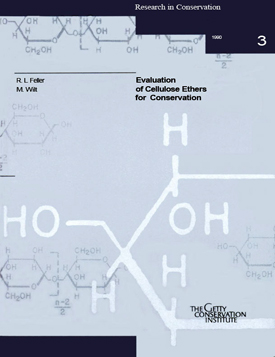
Evaluation of Cellulose Ethers for Conservation
R. L. Feller and M. Wilt
1990
176 pages
PDF file size: 2.08 MB
Description
This report is the result of a three-year research program. It describes the chemical character of cellulose ethers as a general class of polymers and establishes an approximate ranking of the relative stability of each generic chemical subclass. Ranking the thermal stability of the polymers with respect to color change and loss in degree of polymerization led to the conclusion that as generic chemical classes, methylcellulose and carboxymethylcellulose appear to be the most stable of the cellulose ethers. Water-soluble ethylhydroxyethylcellulose apparently also possesses good stability. Of questionable long-term stability are hydroxyethylcellulose and hydroxy- propylcellulose. Ethylcellulose and organic-soluble ethylhydroxyethylcellulose proved to be of poor stability, potentially undergoing marked changes in twenty years or less under normal museum conditions.
An important additional conclusion reached here, as well as in an earlier investigation, is that considerable variations in stability can occur within a generic chemical class from differences in the basic raw material, a natural product from plants, which is not a uniform, manufactured, chemical substance. Further variations can exist due to different manufacturing processes or commercial sources. Hence, commercial products must be evaluated individually to determine the most stable of a given generic type. Nonetheless, the authors believe the conclusions expressed here to be valid with regard to the relative stability of the generic chemical classes of cellulose ethers.
Table of Contents
- Introduction
- Properties of Cellulose Ethers
- Standards of Stability
- Summary of Previous Investigation Supported by the National Museum Act
- Description of Materials and Experimental Procedures
- Results and Discussion
- Conclusions
- Appendices
- References Cited
- Supplementary References
- Index
About the Authors
R.L. Feller is director emeritus of the Research Center on the Materials of the Artist and Conservator, Mellon Institute, Carnegie Mellon University, Pittsburgh, Pennsylvania, following a career of thirty-eight years of research concerning the long-term stability of organic polymers and pigments related to the conservation of museum objects. He is a fellow of the International Institute for the Conservation of Historic and Artistic Works and an honorary fellow of the American Institute for the Conservation of Historic and Artistic Works.
M. Wilt was section supervisor and research consultant on polymer characterization and physical testing at the Research Laboratory, United States Steel Corporation, Monroeville, Pennsylvania, for twenty-two years prior to his retirement. Earlier, he was associated with the Monsanto Company working on special polymers and also with the Kappus Company and the United States Steel Fellowship at the Mellon Institute on a variety of research problems.